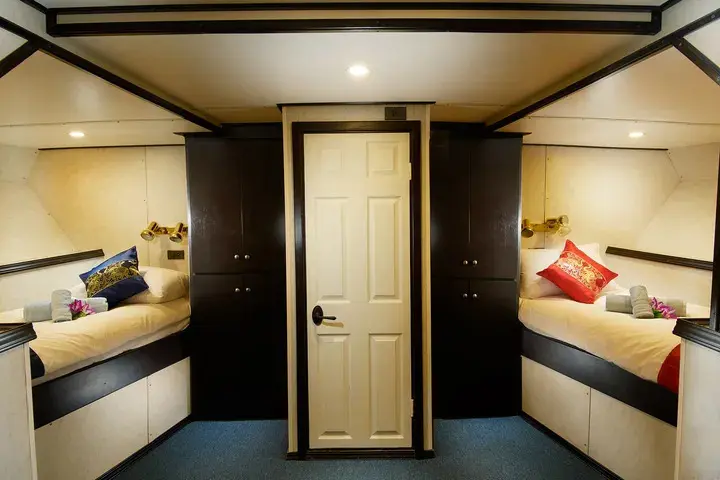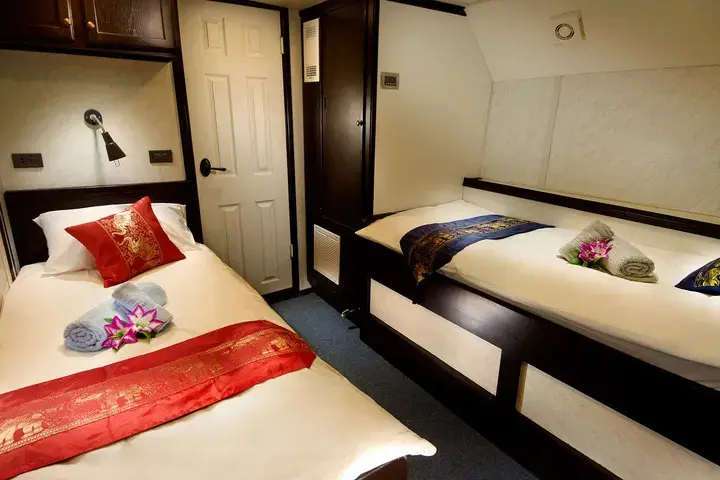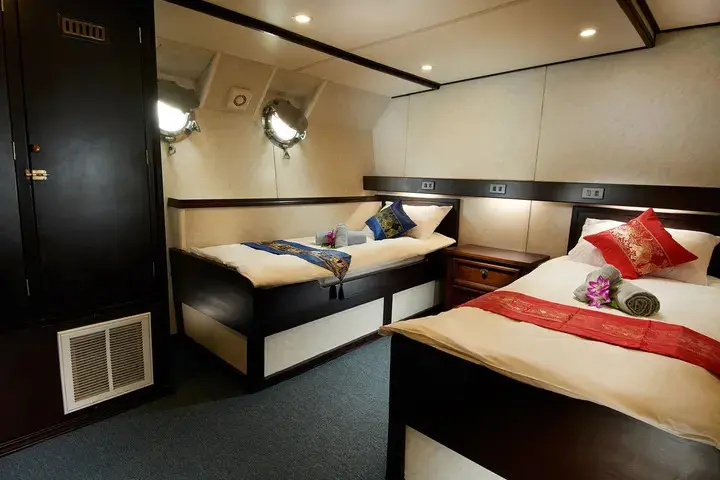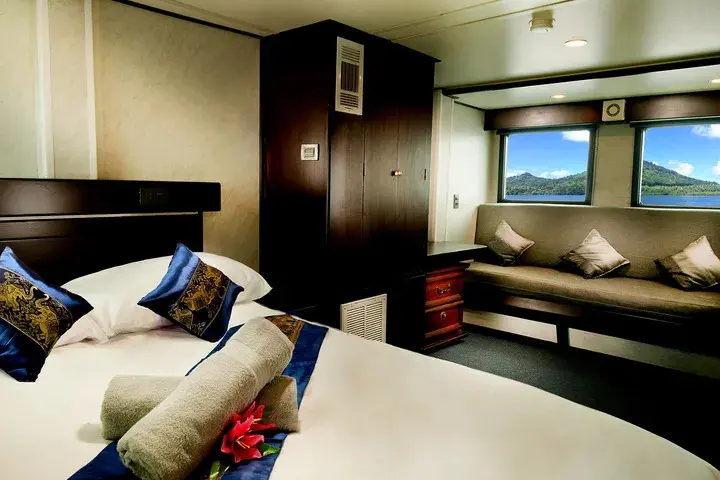The Solomon Islands, a group of islands in the South Pacific, are considered a true paradise for divers.
General information
- Geography: The Solomon Islands consist of over 900 islands with unspoilt coral reefs, lagoons and volcanic islands. They are located to the east of Papua New Guinea.
- Climate: Tropical climate with temperatures between 25-30°C. Best time to dive: April to November (dry season).
Diving highlights
- World War II wrecks: The Solomon Islands are known for numerous wrecks from the Second World War, including ships, submarines and aeroplanes. Popular wreck dive sites include Iron Bottom Sound and Tulagi.
- Coral reefs: The archipelago offers spectacular coral reefs with exceptional biodiversity, including hard and soft corals. Well-known reef systems are the Marovo Lagoon and the Florida Island Reef.
- Large marine life: regular encounters with sharks, manta rays, dolphins and turtles. Whale watching is also possible.
- Macro diving: For lovers of small creatures, the Solomon Islands offer rare species such as nudibranchs, pygmy seahorses and ghost pipefish.
- Caves and canyons: Underwater caves and dramatic drop-offs, such as at Western Province and Mary Island, make for exciting dives.
Diving conditions
- Visibility: Usually very clear, often 20-40 metres.
- Water temperature: Warm all year round, usually between 26-30°C.
This website uses Google Maps to embed map material. Please note that your personal data may be collected in the process. To view the Google Maps map, please agree that it is loaded from the Google server.
Dive in the Solomon Islands aboard the stylish Solomons Master Liveaboard. This 37 metre yacht has been purpose-built to offer keen divers a luxurious, spacious liveaboard experience. With just eight cabins and a maximum guest capacity of 16, the Solomons Master offers an intimate environment with plenty of space to relax and unwind. Choose from Classic, Premium or Superior cabins with en-suite bathrooms, hot showers and individually controlled air conditioning. Divers can look forward to a spacious dive deck with individual equipment stations, storage space under the bench and a large boarding platform with a special deco bar.
The Solomon Master Liveaboard is specifically designed to cater for divers of all levels - from recreational to technical divers. Underwater photographers will benefit from a fully equipped camera station with multiple charging points, a special rinse bucket and plenty of storage space. Outdoor showers are available for a quick post-dive shower, and alfresco dining options allow guests to enjoy the warm Solomon Islands weather. Look forward to three freshly prepared meals served daily in the spacious indoor dining room. Mingle with other guests in the large indoor lounge and bar area, where you can relax with a film or watch the day's photos on the plasma TV. End the day relaxing in a deckchair on the upper sun deck as the sun sets amidst the breathtaking views of the Solomon Islands.
The Solomons Master Liveaboard employs only the most experienced and friendly crew, ready to make a dream diving holiday come true for you. You can expect a highly personalised service and luxurious amenities on the Solomons Master. You will be amazed by the spectacular beauty of each dive site. Travelling throughout the Solomon Islands, the Solomons Master allows divers to experience some of the most spectacular diving in the world. You will encounter pristine hard and soft coral reefs, home to some of the most diverse marine life in the world. Guests often see large pelagic species such as numerous sharks, rays, predatory fish and even the occasional pilot whale while diving with the Solomons Master Liveaboard.
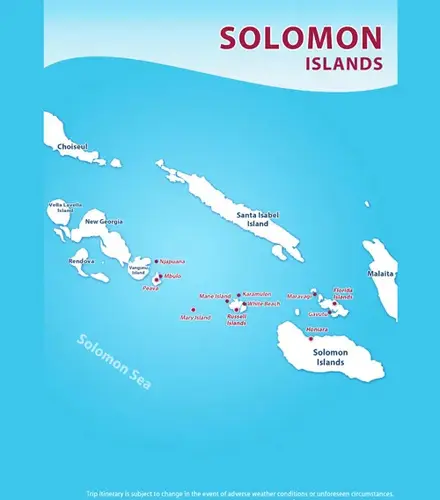
Best of Solomons (Honiara - Honiara) 11D/10N
Some of the dive sites we visit include:
Russell Islands
White Beach
This site was an important American supply base during the Second World War. At the end of the war, an artificial reef was created where lorries, jeeps, tractors, bulldozers and large quantities of ammunition were unloaded.
Leru Cut
This canyon lies just under 100 metres into the island and opens up into the jungle, offering spectacular photo opportunities for silhouettes. Outside the cut is a fabulous wall teeming with fish. Nearby is Mirror Pond with its many swim-throughs and Bat Cave with its resident bat colony.
Custom Caves
These volcanic caves offer amazing photo opportunities when the sun shines through the rock. Lobsters, eels and rays are often found in the caves, while the entrance is covered with soft corals and sea fans.
Ta and Karamulon Point
Patrolling white and black tip reef sharks usually greet us here as they start their day along the wall. White-spotted eagle rays can also be found in deep water.
Fish market
The name of this dive site comes from the huge shoals of fusiliers and bannerfish.
Mary/Mborokua Island
This island is characterised by an underwater point that is often home to schools of barracuda and mackerel. Explore the inlets and caves behind Jack Point or the Coral Gardens directly below the boat.
Marovo Lagoon
This is a double-barrier reef that is considered the largest saltwater lagoon in the world.
Other dive sites:
Kavachi Korner
Mbulo Island
Florida Islands
Tulagi
Twin Tunnels
Passage Rocks
Tanavula Point
Ed's Wall
During the cruise we organise at least one visit to a village where you can meet local families and see how the Solomon Islands people live. The children come to play and love our gifts of school supplies. Check out our Pack for a Purpose programme to see how you can help.
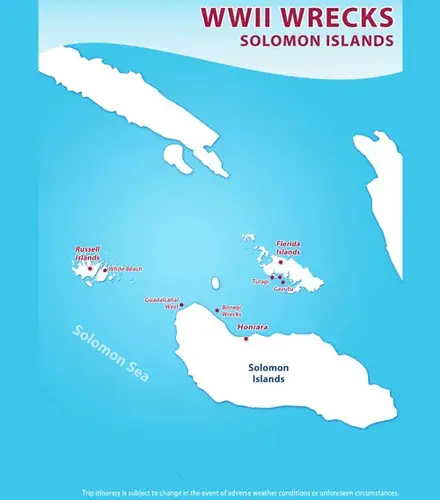
Florida and Russell Islands (Honiara - Honiara) 8D/7N
This itinerary is planned by our local captain according to weather and current conditions, but you can be excited because it will exceed your expectations.
Expect to see bumphead parrotfish, bamboo sharks, marble rays, nudibranchs, dark sharks, jawfish, bubble coral shrimps, leaf fish, porcelain crabs, pygmy seahorses, schools of barracuda, mackerel and jackfish, whitetips, blacktips, grey reef sharks, turtles, octopus, frogfish, manta rays, dugongs, banded pipefish, mandarinfish, wonderpus, Indian walkman
Classic Twin Cabins
- 2 single beds Twinn,
- en-suite bathroom,
- adjustable air conditioning,
- 2 guests
Premium Twin Cabins
- 2 single beds Twinn,
- en-suite bathroom,
- adjustable air conditioning,
- 2 guests
Premium Twin/Double Cabins
- 2 single beds, twinn/ or 1 double bed,
- en-suite bathroom,
- adjustable air conditioning,
- 2 guests
Superior Double Cabin upper Deck
- 1 double bed,
- en-suite bathroom,
- adjustable air conditioning,
- 2 guests
Included: VAT, airport transfers, hotel transfers, soft drinks, tea & coffee, drinking water, snacks, full board (all meals), diving packages, shore excursions, towels for use on deck, cabin towels, complimentary toiletries.
Obligatory extras: National park fees (175-250 EUR).
Optional extras: gratuities, alcoholic drinks, rental equipment, nitrox, diving courses (100-325 USD), laundry/ironing service (1 USD per item), WiFi (70-175 USD).
Prices for rental equipment:
Rental equipment is available on this vessel. Please indicate what you need on the booking form. Details below of what is included and the additional prices.
- Regulator 12 USD per day
- BCD 12 USD per day
- Fins 5 USD per day
- Mask 5 USD per day
- Nitrox bottle 25 USD per day
- Signal buoy 5 USD per day
- Torch 6 USD per day
- Dive computer 12 USD per day
- Full equipment (with: regulator, BCD, fins, mask, snorkelling set, wetsuit) 45 USD per day
- Wetsuit 12 USD per day
- Air temperature: Stable all year round between 24.8 °C and 25.5 °C.
- Water temperature: Constantly warm between 27.3 °C and 28.7 °C, ideal for diving.
- Precipitation: Highest in January (380 mm) and March (365 mm), lowest in June (183 mm).
The Solomon Islands are an island nation in the South Pacific, east of Papua New Guinea and north-east of Australia. It consists of around 990 islands, of which around 350 are inhabited. The most important island groups:
Guadalcanal (with capital Honiara
New Georgi
Santa Isabel
Rennell & Bellona
Russell Islands
Florida Islands
The islands are located in the Coral Triangle, one of the world's most biodiverse marine ecosystems.
Population
Around 740,000 inhabitants, mainly living in rural coastal regions.
The population is ethnically predominantly Melanesian, with small Polynesian and Micronesian minorities.
There are many traditional tribal cultures with their own languages (over 70 indigenous languages).
English is the official language, but Pijin (Solomon Creole) is used in everyday life.
Religions
Over 90 % of the population are Christians, mainly:
Anglicans
Catholics
Evangelical Free Churches
Religious life is deeply embedded in everyday life, often combined with elements of traditional spirituality (e.g. ancestor worship).
Economic situation
The Solomon Islands are one of the least economically developed countries in the region. Most important sectors:
Agriculture (coconut, cocoa, palm oil)
Fishing
Timber export (partly controversial due to environmental destruction)
Tourism (still in its infancy, but growing)
Infrastructure and transport connections are often inadequate - many places can only be reached by boat or small aeroplane.
Significance for eco & diving tourism
The Solomon Islands are considered one of the best-kept secrets in the diving sector. Due to their remoteness, the reefs are largely untouched.
Intact coral reefs
Wrecks from the Second World War (e.g. in Iron Bottom Sound)
Cliffs, caves, macro spots and big fish sightings
The focus is on small-scale, sustainable tourism with close involvement of the local communities.
Economic impact of the diving industry
Still a relatively small sector, but important for certain island groups (e.g. Gizo, Munda, Tulagi, Uepi).
Jobs in resorts, diving centres, boat services, crafts
Promotion of marine conservation projects
Investments in education, local infrastructure and community projects
Many diving resorts work closely with the villages (e.g. compensation for reef use, school projects).
Challenges:
Logistical difficulties & high costs for international travel
Limited medical care and emergency infrastructure
Danger from climate influences, coral bleaching and unsustainable fishing
Why the Solomon Islands are a favourite destination for divers
Unspoilt, remote reefs without mass tourism
Excellent visibility & great biodiversity
World-class wreck diving - especially in the region around Guadalcanal ("Iron Bottom Sound")
Mix of big fish, macro and topography - steep walls, caves, mangroves
Authentic cultural experiences - traditional villages, dance, handicrafts
Small, exclusive eco-resorts - ideal for individual travellers and underwater photographers
Best time to visit: April-November (drier, more stable sea)

